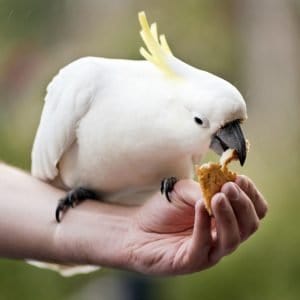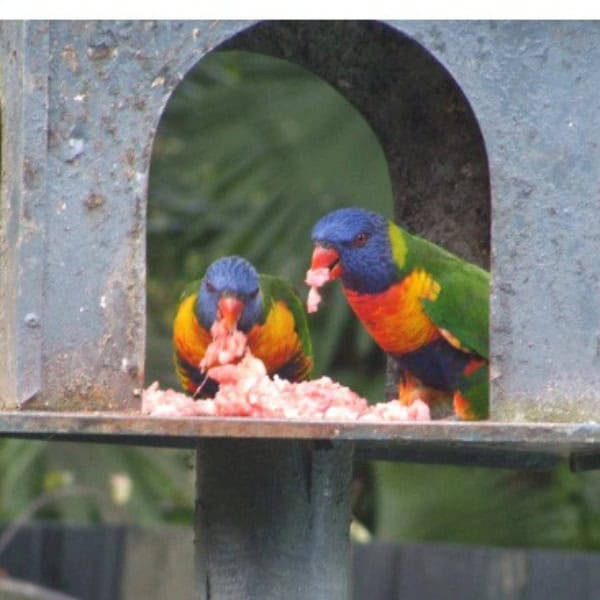
Do Parrots Eat Meat? Rainbow Lorikeets Prefer It Raw
Last Updated on by Mitch Rezman
Jean relates,
I used to breed African greys, macaws, grey cheeks 30 years ago. I kept 2 of my African greys (unrelated) and are now 42 years old & totally healthy.
The male likes carbohydrates but the female loves MEAT. I can put in a drumstick (fully cooked chicken partially removed for the other AG, veggies (peas, carrots, string beans, corn) sweet potatoes, organic brown rice, kewa, (all organic, antibiotic free) plus they have pellets and human grade seed.
They wait for their dinner then dive in the minute I put the bowl in their cage. The female goes right for the bone & chicken, kale for the carbs, rice & kewa. I have been feeding them this diet for over 15 years.
If I put filet mignon on a fork (2 pieces) they rush over and not a drop falls on the bottom of the cage.
The vet was shocked I gave them meat. But you can’t force a bird to eat what it doesn’t want to eat when it gets so many other options are truly spoiled.
I was wondering if other parrots are meat eaters.
Here’s what we know Jean
In the verdant suburbs and vibrant cities of Australia, nestled among the nectar-rich blossoms of callistemons and grevilleas, a curious transformation has unfolded, one that hints at the intricate dance between humans and wildlife.
The Rainbow Lorikeet, a bird adorned with a dazzling array of colors and known for its nectar-feeding habits, has begun to exhibit a surprising dietary shift—meat consumption.
Historically, the people of Australia, like their counterparts in North America and the United Kingdom, have engaged in the pastime of feeding wild birds, albeit with a peculiar twist.
Australian backyards often become stages for a diverse cast of avian characters, including the granivorous Rainbow Lorikeet and insectivorous species such as the Australian Magpie and the Laughing Kookaburra. Unlike the seed mixtures commonly offered in the Northern Hemisphere, Australian feeders sometimes tempt their feathered guests with an unusual offering—meat.
This novel trend came to light following a 2015 media report which captured the nation’s fascination: a pair of Rainbow Lorikeets were observed partaking in a meal of beef mince, a delicacy ostensibly intended for their carnivorous neighbors.
This incident prompted researchers from Griffith University’s Suburban Wildlife Research Group to delve deeper into the phenomenon. Through a national survey, they uncovered that across the vast stretches of the Rainbow Lorikeet’s domain, from bustling urban centers to serene suburban oases, these birds have not only embraced meat but have been doing so for over five years in many locales.
Such dietary adventurism among Rainbow Lorikeets is not merely an isolated curiosity but signals a broader, well-established shift. As gardens brimming with nectariferous flora have lured these birds into urban landscapes, human-provided feeders have become unexpected sources of nutritional supplementation, blurring the lines between natural and human-influenced dietary habits.
This development raises intriguing questions about the impact of human practices on wildlife behavior and health. As these nectar-loving birds navigate the smorgasbord of urban feeding stations, the implications of their newfound carnivorous proclivities invite contemplation.
Are we witnessing a harmless extension of the lorikeets’ natural dietary flexibility, or could this mark the beginning of nutritional imbalances and unforeseen ecological consequences?
In the end, the story of the Rainbow Lorikeets’ carnivorous turn is a testament to the resilience and adaptability of nature in the face of human encroachment.
It beckons us to think deeply about our role in shaping the lives of our wild neighbors and the unpredictable ways in which they adapt to the ever-changing tapestry of the world we share.
Our goal was to explore how often and where Rainbow Lorikeets eat meat, to learn about the history of this behavior, and to think about what it means for the birds and bird feeding in general.
We gathered data through an online survey made just for this. People were invited via over 500 emails, and media mentions from March 2015 pointed folks our way. After we made sure only Aussies seeing wild birds eat meat responded, we emailed them a link to our survey.
This survey, hosted by Survey Monkey, was anonymous and officially approved. It asked about where they lived, if they fed birds, what food they gave, and details about the meat-eating lorikeets, among other things.
Out of 328 people emailed, 144 filled out the survey. Almost all of them fed birds, mostly daily, and many had been doing it for over a decade. They offered a mix of foods, with meat and seeds being top choices.
When it came to meat eaters, aside from expected carnivores, a shocking 87.9% reported Rainbow Lorikeets at their meat dishes. Other birds, like rosellas and pigeons, were also named. The lorikeets were seen across a big part of their range, mainly where lots of people live. Some noticed the behavior recently, while others had seen it for years. Lots of folks mentioned that lorikeets would often keep other birds away from meat.
While our survey has limits, it showed us that Rainbow Lorikeets eating meat isn’t rare. It’s happening across a big area and has been for some time. This habit, unusual for a bird known for its sweet tooth, suggests these birds and others are adapting to the food humans offer, which is different from their natural diet.
This change could be linked to urban life, where birds learn to eat what’s available. Meanwhile, in other places, bird feeding practices might not include meat, with the UK’s Red Kites as an exception.
Feeding wild birds, though well-meant, can lead to unexpected changes in what birds eat. This story of lorikeets diversifying their diet is a clear example of how urban surroundings and human actions can reshape wildlife behavior.
In Australia, there roams a bird with a sweet tooth, the Rainbow Lorikeet. These birds love to chase after the blooms of trees and bushes across the vast lands, hunting for nectar and pollen. But Australia’s sweets can be as fickle as the weather, leaving the lorikeets to look elsewhere when times get tough.
Enter the insects – a feast of beetles, moths, and other tiny critters becomes their diner of choice. And it turns out, these nectar lovers are not too picky, happily munching on meat when the chance arises.
One day, a story spread wide and far, telling of lorikeets at garden feeders feasting not just on seeds and sweets but on meat.
Data from a survey showed a surprising number of these brightly colored birds joining magpies and butcherbirds at the meat buffet. Turns out, this was not just a one-off. Over 500 emails flooded in with tales of lorikeets, both homebound and wild, eagerly eyeing the meat on folks’ plates or nibbling at the remains of larger beasts in the fields.
This appetite for meat might seem odd for a bird we think of as living on a diet of nectar and pollen. But, the Rainbow Lorikeet is nothing if not opportunistic, with a diet stretching far beyond what we imagined. From grains to fruits and now to meat, they show us they’re not just about the sweet life.
The story of the lorikeets is a bit like humans and our craving for sugars and fats. Just as we’ve gone from rare treats to super-sized servings, these birds have found a steady stream at our feeders.
Yet, just as with us, too much of a good thing can lead to trouble. Feeding on meat alone, especially the beef mince often offered, could mess with their health, much like eating only candy would for us.
Though these birds rarely depend solely on human offerings, the story reminds us of the unexpected turns nature can take and the surprises awaiting when we really pay attention. Just like us, the Rainbow Lorikeet’s tastes are varied and sometimes, just sometimes, they show us they’re not so different after all.
Written and Approved by Mitch Rezman and the Windy City Parrot Content Team
Author Profile
Latest entries
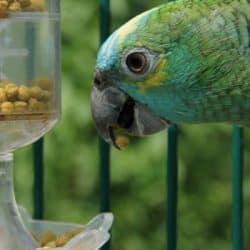 Feeding Exotic BirdsDecember 29, 2025How to Switch or Convert Your Bird From Seeds to Pellets: Real-Life Case Studies and Practical Guidance
Feeding Exotic BirdsDecember 29, 2025How to Switch or Convert Your Bird From Seeds to Pellets: Real-Life Case Studies and Practical Guidance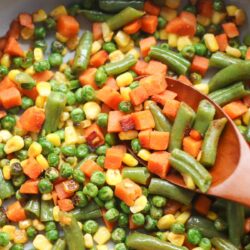 Feeding Exotic BirdsDecember 16, 2025A Practical, Budget-Smart Guide to Feeding Birds Well
Feeding Exotic BirdsDecember 16, 2025A Practical, Budget-Smart Guide to Feeding Birds Well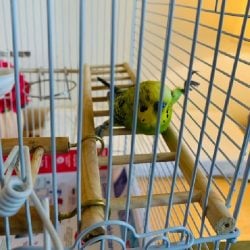 Bird EnviornmentsDecember 7, 2025Understanding Budgie Cage Bar Orientation: Myths, Realities & Practical Solutions for Vertical-Bar Bird Cages
Bird EnviornmentsDecember 7, 2025Understanding Budgie Cage Bar Orientation: Myths, Realities & Practical Solutions for Vertical-Bar Bird Cages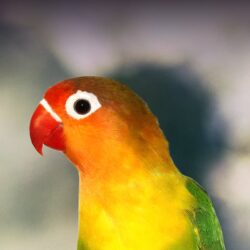 Feeding Exotic BirdsDecember 5, 2025How Dr. T.J. Lafeber Rewrote the Future of Pet Bird Nutrition
Feeding Exotic BirdsDecember 5, 2025How Dr. T.J. Lafeber Rewrote the Future of Pet Bird Nutrition
